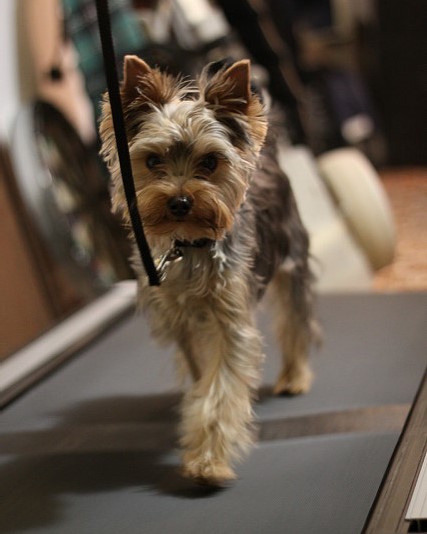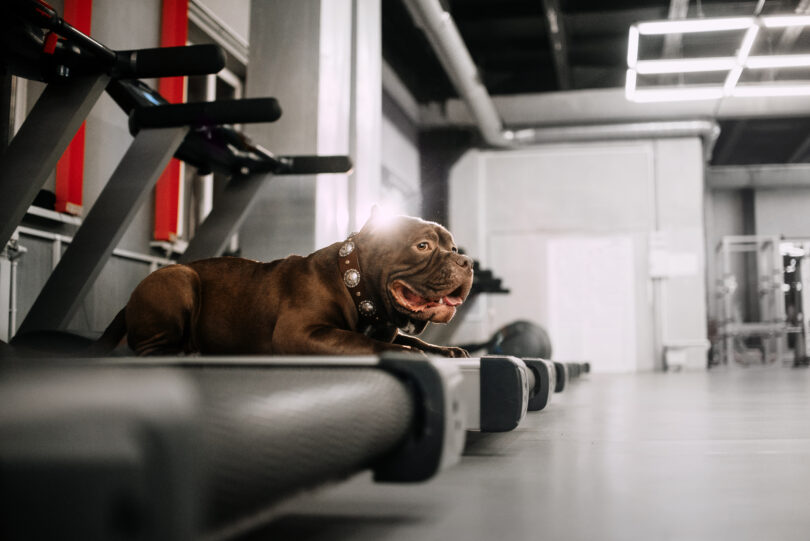A lot of dog owners want to be able to exercise their dogs at home. People focus a lot more on their health and fitness goals nowadays, so it only is natural for them to want their dogs to do it too!
But can dogs safely use a human treadmill?
Treadmills come in handy: they offer a high-quality intensive training outlet for dogs while being at home, indoors, to make it easily doable. However, the best dog treadmills are priced around the $500-mark, sometimes even more.
Dogs owners immediately wonder whether or not the cost is justified when they could use their own or buy a new human treadmill. After all, a treadmill is a treadmill, right?
Well, it’s not that quite that simple…

Photo: Scott Adams, Flickr
Dogs Should Only Use Dog Treadmills
Let’s start by giving the short answer: dogs should run and get their conditioning on a dog treadmill. Full stop. It’s about safety, and that should come first in your priority list.
Dog treadmills are not repackaged and rebranded human treadmills despite what you might think. They may look relatively similar, but have several features that are, by design, safer for and more adapted to dogs.
Reasons Why Human Treadmills Are Dangerous For Dogs
If you are going to use a treadmill to replace outdoor exercising and walks, you should not even think about it, simply because you will end up putting your dog on the treadmill lazily and skip the part where you must supervise him or her at all times.
If you are trying to enhance your dog’s current activity, go for the treadmill. However, you need to invest in a quality dog treadmill instead of using your human treadmill. And here are the reasons why!
Position of the Motor Compartment
Humans don’t have fur hanging out from their feet, therefore the location of the motor and ventilation grid matter very little. However, for dogs, there is a high risk of an accident if your dog’s long coat was to get churned by the ventilation and motor.
Another problem is the quantity of hair and dust that can enter the motor compartment through the ventilation grid. Dogs lose their hair a lot more than we do and most dog treadmills do not cover dirt in case of a problem.
Dog treadmills place the motor and ventilation in an adequate position to avoid all of the above.
Noise and Vibrations
Still on the motor — vibrations and volume are extremely problematic with some dogs. The smaller the dog, the more the vibrations will bother the running experience and even the gait.
If your dog has never run on a treadmill before, the loud noise of a typical human treadmill will cause him or her some anxiety and might spoil the fun. The last thing you want with a new activity is to spend weeks just to get them to relax.
Dog treadmills use materials, motors, and technologies that specifically reduce both the noise and the level of vibration when running at a high-speed range.
Lack of Adequate Side Rails
Treadmills that humans use have high side rails that aren’t of any help whatsoever to a dog, even a large breed. They are just too high up.
Rails are a visual guide for all runners, canine or human, to focus on stepping forward rather than floating too much on the sides.
Experienced runners can run for hours without rails, but most people need them at least to start off. The same applies for dogs, and k9 treadmills offer these without a doubt, and they are low enough actually to be useful for all dogs of all sizes.
Narrow and Short Tracks
While running, dogs float a lot more than humans. Dogs float back and forth as well as side to side. Human treadmills come with a narrower and shorter track which would be too small for a dog.
Instead, a quality dog treadmill must offer a wider belt as well as longer track than those provided by most human treadmills, especially home models.
There is no official requirement or measure here because it depends on the dog’s size, breed and running style or gait. Some dogs extend their legs to some incredible length while others are fine with less length.
Gaps Between Belt and Edges
Human treadmills, if you observe carefully, will have gaps of a few millimeters between the running belt and the frame’s edges. This happens because it is easier to assemble and doesn’t bother human runners at all.
Dogs tend to float more than humans when running and one of their claws could, unfortunately, get trapped into one of these gaps and cause some irreparable harm to your dog.
Dog treadmills are built without these gaps by default to ensure maximum safety.
Lack of Very Slow and Very Fast Speeds
Large dogs are usually content with the speed settings offered by a human treadmill – of course, they would run with more ease than us at high speed, but it would still be challenging enough to them!
However, as soon as you are putting a smaller dog onto a human treadmill, the speed settings are becoming unsuited for this smaller type of dogs.
Dog owners don’t realize how slow a little dog is compared to a human, and how many steps are required for a Pomeranian or Beagle to reach an average-paced human. The slow speed settings should be granular, and most quality dog treadmills offer that granularity by default.
Why you Should opt for a Dog Treadmill
Many people are training their dogs on their human treadmill, and they have been doing it for a long time without any problem. However, I would never recommend doing it because an accident can quickly happen and the possible guilt is not worth the savings.
If you are not ready to invest in a quality dog treadmill such as those below, wait until you can and try some other indoor dog-friendly exercises instead.
One thing dog owners should never do is to compromise their dogs’ safety!







